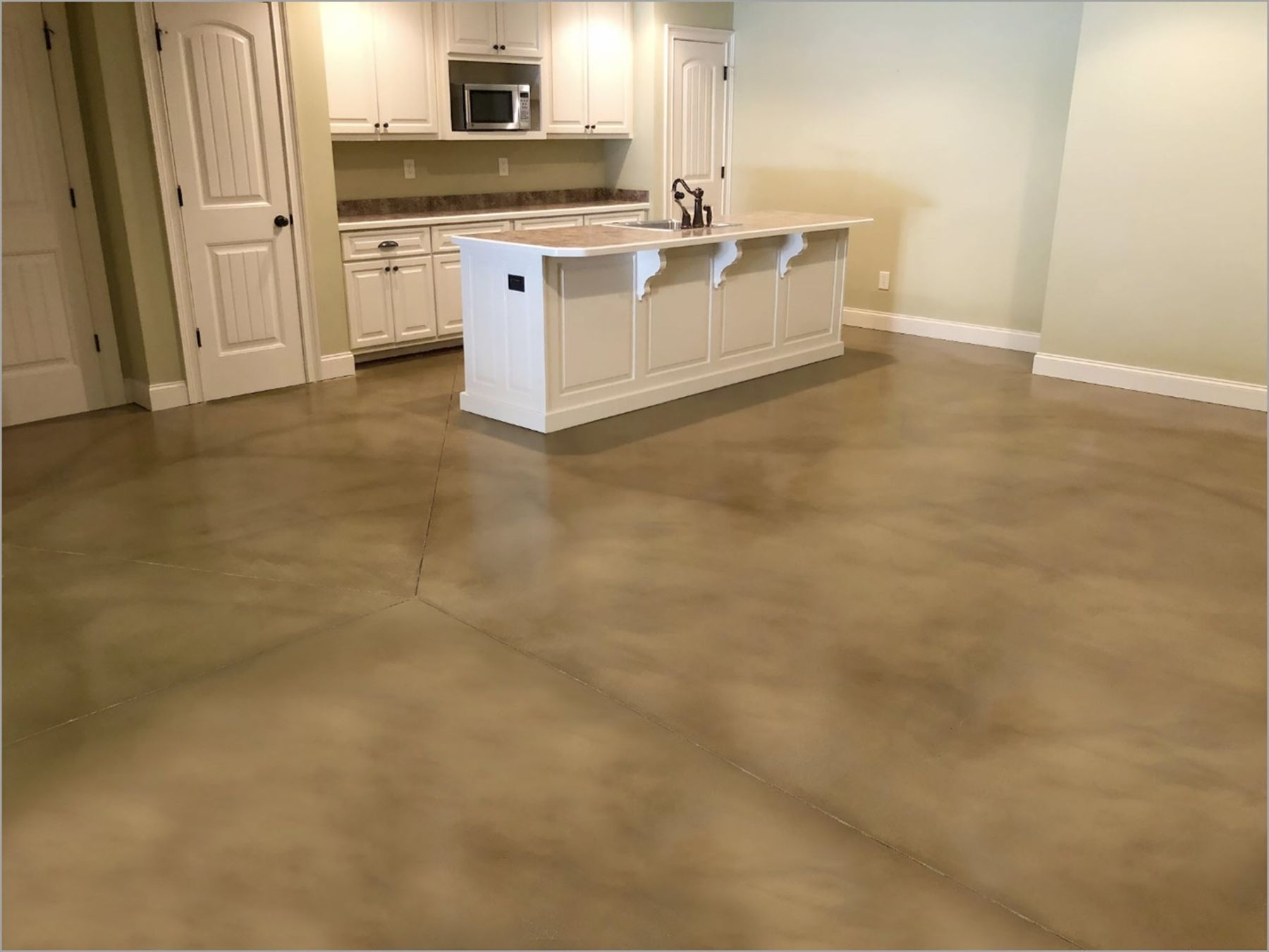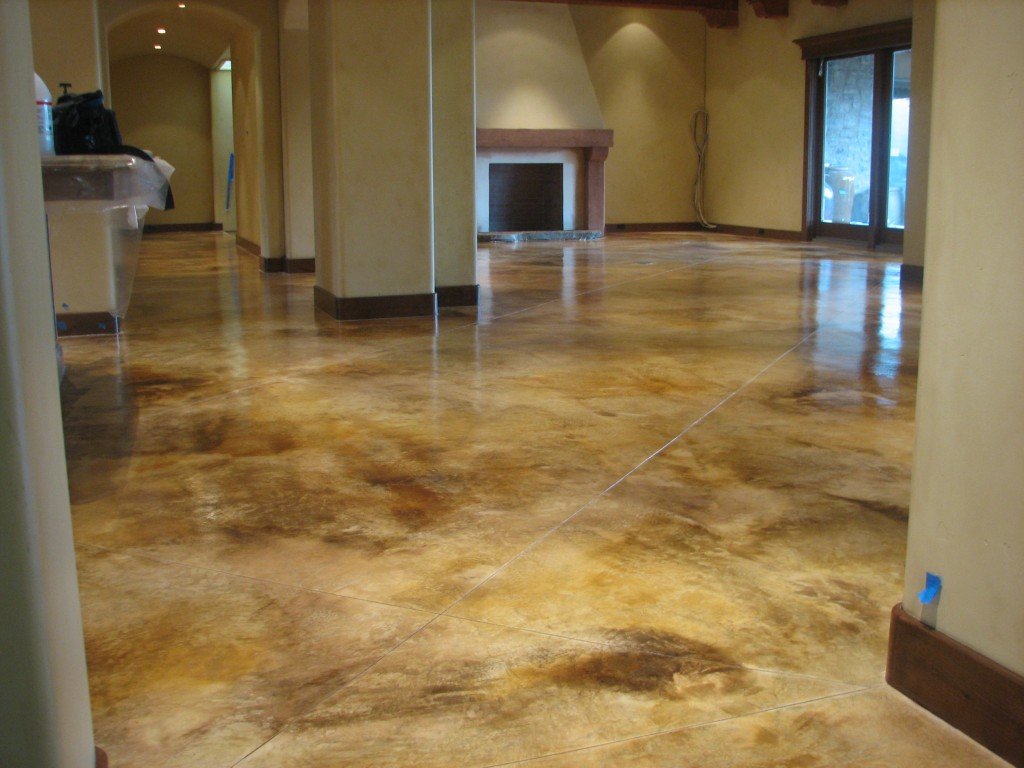Why stained concrete a low-maintenance choice for flooring
Understanding the Various Kinds Of Stained Concrete for Your Next Task
Stained concrete offers different options that satisfy various aesthetic and functional demands. Each kind provides distinct qualities that affect the final look and resilience of the surface. Understanding these differences is vital for any person planning a project. From abundant, chemical responses of acid-based stains to the vibrant harmony of solid shade stains, the selections can substantially affect the outcome. What variables should one think about when selecting the suitable discolor for their particular needs?
Summary of Stained Concrete
Stained concrete acts as a flexible floor covering choice that can enhance the visual appeal of various spaces. This technique includes using a tinting agent to the surface of existing concrete, permitting a broad spectrum of layout possibilities. Stained concrete is popular in both domestic and commercial settings, supplying a resilient and low-maintenance service that can imitate the appearance of all-natural products like rock or ceramic tile.
The staining process can be carried out making use of water-based or solvent-based items, each supplying distinctive aesthetic effects. The last look is affected by variables such as the original concrete surface, the kind of tarnish made use of, and the application method. Stained concrete not only enhances exterior and interiors but also promotes sustainability by rejuvenating existing concrete frameworks. As a result, it has actually gotten traction among home owners and designers seeking both functionality and design in their flooring options.
Acid-Based Stains: Characteristics and Advantages

Unique Shade Variations
Concrete surface areas can change considerably with the application of acid-based stains, which supply an abundant combination of distinct color variants. These stains permeate the concrete, responding chemically to generate dynamic earth tones that range from deep browns and reds to soft greens and blues. The resulting hues are often variegated, creating a natural, marble-like appearance that enhances the concrete's character. Each application yields unique outcomes as a result of variations in the concrete's make-up and the staining technique used, making every task one-of-a-kind. In addition, acid-based stains can be split or integrated with other methods to develop tailored designs, permitting personal expression. This versatility makes acid-based stains a popular choice for both domestic and industrial applications.
Chemical Responses Clarified
While several aspects add to the efficiency of acid-based stains, the underlying chain reaction play a crucial role in their unique attributes and advantages. These stains largely are composed of water, acid, and metallic salts. When applied to concrete, the acid responds with the calcium hydroxide in the cement, developing a chemical makeover that leads to long-term color modifications. The metallic salts penetrate the surface area and bond with the concrete, enabling a wide variety of tones and tones. This response not only enhances visual charm but additionally offers resilience, making the color immune to fading and wear. Additionally, acid-based stains can develop a variegated surface that mimics all-natural stone, further boosting their appeal for decorative concrete applications.
Surface Prep Work Significance
Attaining suitable results with acid-based stains rests on complete surface prep work. This vital action guarantees that the concrete surface area is clean, free of pollutants, and appropriately profiled for optimal discolor absorption. Any kind of existing sealants, dirt, or oils can prevent the chemical response that generates the desired shade and coating, resulting in irregular or patchy results.
Prior to applying the tarnish, the concrete ought to be mechanically cleaned up or stress washed, adhered to by a thorough assessment for cracks or flaws that may call for repair. In addition, validating the surface is effectively dried out will enhance discolor adherence. By focusing on these primary procedures, the long life and vibrancy of acid-based stains can be substantially boosted, resulting in an extra cosmetically pleasing and sturdy finish.
Water-Based Stains: Functions and Advantages

Water-based stains permeate the concrete, using an extra translucent surface that highlights the all-natural structure and variants of the surface area underneath. They are available in a large selection of colors, permitting innovative flexibility in layout. Additionally, water-based stains are less complicated to cleanse up, calling for only water and soap, which streamlines the application process.
Their quick drying time improves performance, making them a practical choice for both DIY lovers and experts. Overall, water-based stains offer an attractive mix of visual versatility and user-friendly residential or commercial properties, making them a prominent alternative for concrete improvement tasks.
Strong Shade Stains: Lively Choices for a Strong Look
Solid color stains offer an effective service for those seeking to create a vibrant and lively visual on concrete surface areas. These stains provide an uniform coloration that can considerably improve the visual charm of floors, patio areas, and driveways. Offered in a vast spectrum of hues, solid color stains enable for imaginative expression, accommodating different style choices.
One of the key advantages of solid shade stains is their capability to conceal blemishes, providing a fresh and polished want to maturing concrete - local stained concrete. Furthermore, their formulation usually includes UV-resistant homes, ensuring long life and shade retention even in rough weather
Application is uncomplicated, needing minimal prep work of the concrete surface. Once used, solid color stains can be secured for included security and sheen, more raising their visual high quality. With their vibrant choices, solid color stains are an excellent selection for those aiming for an impactful and natural layout.
Semi-Transparent Stains: Attaining Deepness and Dimension
Semi-transparent stains use a distinct strategy to enhancing concrete surfaces by providing depth and dimension through different shade alternatives. Comprehending the application strategies is necessary for achieving the preferred impact, while correct maintenance methods guarantee longevity. This area will certainly explore these vital facets to navigate to this website make best use of the advantages of semi-transparent staining.
Color Options Available
A variety of shade options exists for semi-transparent stains, enabling home owners and designers to improve the all-natural beauty of concrete surfaces. These stains are available in a variety of tones, from earthy tones like browns and terracottas to vibrant shades such as blues and greens. The semi-transparent nature of these stains allows the underlying concrete to show with, developing an unique depth and dimension that can complement different style looks. Additionally, integrating various shades can create custom-made tones, making it possible for a customized search for each project. This versatility makes semi-transparent stains a prominent option for both interior and exterior applications, as they can balance with surrounding elements while including aesthetic rate of interest to plain concrete.
Application Techniques Discussed
To accomplish the desired depth and dimension with semi-transparent stains, correct application methods are necessary. Initially, surface area prep work is important; the concrete has to be tidy and without any type of pollutants. This typically involves power cleaning and repairing any fractures. Next, picking the best applicator, such as a sprayer, roller, or brush, can affect the last look. Sprayers allow for a more also application, while rollers can assist achieve appearance. It is necessary to apply the tarnish in thin, also layers, allowing each layer to completely dry prior to including another. Adjusting the application method, such as varying stress or utilizing various tools, can develop one-of-a-kind impacts. Sealing the stained surface area enhances the vibrancy of the colors while giving security.
Upkeep Best Practices
Routine upkeep is necessary for maintaining the beauty and honesty of surfaces treated with semi-transparent stains. To preserve these surface areas, regular cleaning is important. Utilizing a pH-neutral cleaner and a soft-bristle mop will certainly aid More hints get rid of dirt and debris without damaging the discolor. It is advisable to avoid extreme chemicals, as they can weaken the stain's appearance. Furthermore, periodic resealing every one to three years can secure versus wear and fading. This process involves cleaning up the surface area extensively and applying a suitable sealant designed for stained concrete. Home owners should also keep track of for any type of indicators of staining or damages and address these issues quickly to assure resilient vibrancy and resilience. Adhering to these best practices will certainly improve the total life-span of semi-transparent stained surfaces.
Results and Techniques: Tailoring Your Stained Concrete
Tailoring stained concrete involves a range of techniques that enhance both appearances and functionality. Amongst these methods, layering different stain shades can produce deepness and intricacy, enabling one-of-a-kind visual impacts. Techniques such as acid staining supply a variegated look, while water-based stains provide a more uniform appearance.
Additionally, including attractive patterns, such as stenciling or inscription, can further customize the surface area, adding elaborate designs that deal with private tastes. Texturing the concrete, whether via stamping or broom coatings, introduces tactile components that not just enhance grip yet likewise enhance aesthetic interest.
Furthermore, applying sealers can amplify the shade vibrancy and offer protection versus wear. Personalization techniques prolong past simple shade; they can transform a common concrete piece into a spectacular centerpiece, making it suitable for both residential and industrial rooms. With mindful selection of results and techniques, stained concrete can attain a really customized appearance.
Maintenance and Long Life of Stained Surfaces
Although stained concrete surfaces are understood for their durability and aesthetic appeal, preserving their honesty is important for ensuring longevity. Normal cleansing is important; sweeping and mopping with a pH-neutral cleaner aids prevent dirt build-up and discoloration. Additionally, applying a sealer every couple of years can shield the surface from wetness, chemicals, and UV damages, thereby improving its life expectancy.
It is additionally vital to more helpful hints address any splits or chips quickly. Tiny repairs can mitigate further wear and tear, maintaining the visual and structural quality of the surface. For outside stained concrete, seasonal upkeep, such as eliminating snow and ice, is necessary to stop surface damage from freeze-thaw cycles.
Often Asked Concerns
Can I Discolor Existing Concrete Surfaces or Only New Ones?
The concern of whether existing concrete surface areas can be stained occurs regularly. It is certainly feasible to discolor both brand-new and old concrete, supplied the surface is sufficiently prepared and devoid of pollutants for perfect attachment.
Exactly how Long Does the Discoloration Process Generally Take?
The discoloration process commonly takes one to three days, relying on elements such as surface area prep work, sort of stain, and weather condition conditions. stained concrete company. Curing time might extend beyond initial application, affecting the total duration substantially
Is Stained Concrete Safe for Outdoor Use?
Stained concrete is typically secure for outside usage, offered it is effectively sealed. This sealing safeguards against dampness and UV damage, making sure toughness and safety and security, while also boosting the aesthetic appeal of outdoor areas.
Can I Use Numerous Discoloration Layers for Different Impacts?
Using numerous stain layers can attain varied impacts on stained concrete. It is necessary to assure compatibility in between stains and allow proper drying time between applications to stay clear of unplanned reactions or discoloration.
Are There Any Type Of Shade Limitations for Stained Concrete?
Shade limitations for stained concrete largely rely on the type of discolor used, with water-based stains using a more comprehensive scheme contrasted to acid-based stains. stained concrete contractors. Accomplishing dynamic shades might need cautious selection and application techniques.